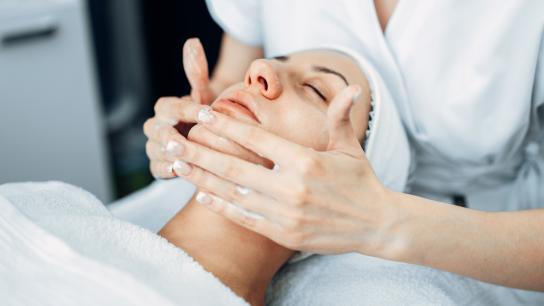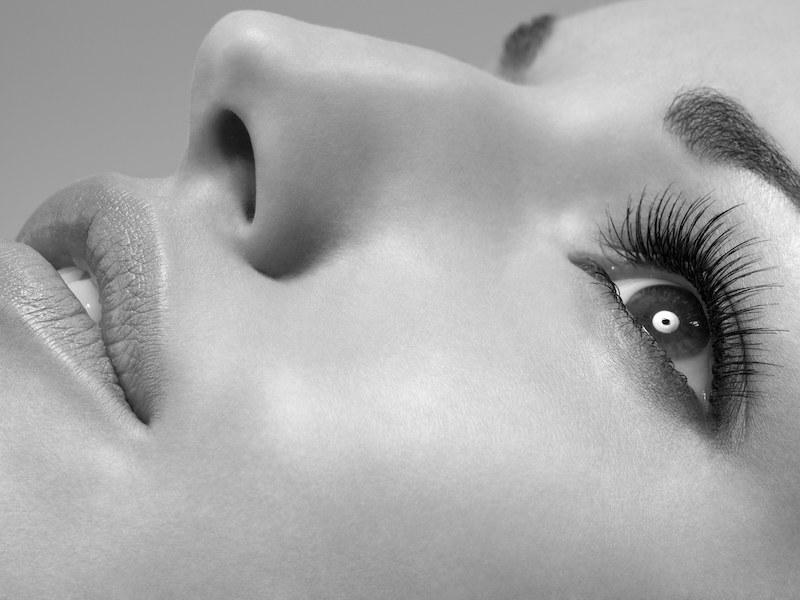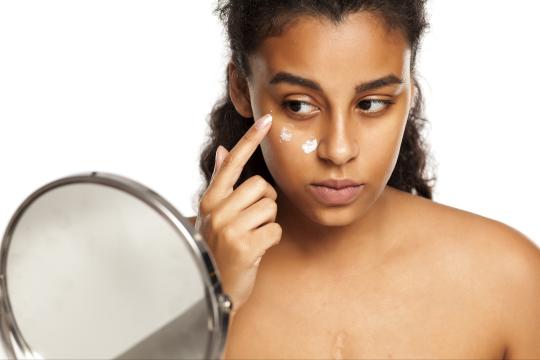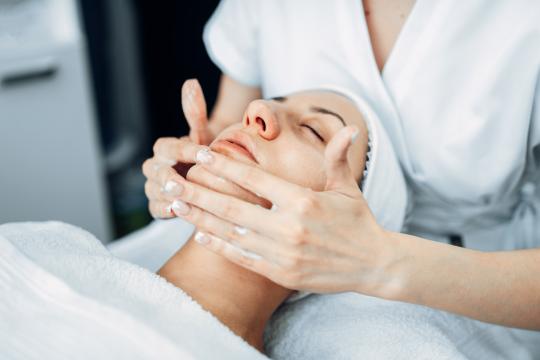
Luminous. Dewy. Taut as a baby’s bottom. There are certain words and phrases that we'd like to have our complexions compared to. “Saggy” ain’t one of ‘em. And yet many of us, at some point or another, will find ourselves in front of a mirror, lamenting a drooping jaw or sagging cheek, and using our thumb and forefinger to gently lift our faces back to their once-youthful position. We might also be crying. *sob
Today we’re going to address the one sign of aging that you may dread more than all the others: facial sagging. Think a drooping jowl or wobbly chin, a dropped cheek or sagging undereye area and you'll get the horrifying picture. So let's discuss. What causes facial sagging? What can you do about to help prevent it? And what can your doctor do about it once it's already happened?
What causes facial sagging?
A sad, saggy face is caused by a loss of elasticity in the skin. Unfortunately, this occurs naturally during the aging process. As skin gets older it produces less collagen, which leads to less elastin, which just so happens to be the very thing keeping youthful skin nice and taut. Think of the oldest swimsuit bottoms that you own. The elasticity eventually deteriorates and no amount of gentle hand washing and air drying can fix that. It's inevitable, and one day, you'll pull those bottoms on and they'll simply fall back to the floor in a sad little heap of saggy fabric. *sob. You can point the finger of blame at genetics and Father Time until the cows come home, but there's someone else who can take a share of the blame too. That person is you. Poor eating habits, unhealthy lifestyle choices, smoking, stress and environmental factors like unprotected sun exposure can all play a part in the premature sagging of your face. And we're not here for that. So let's look at some of the ways that you can keep your face from falling prematurely.
Prevention is the best medicine.
- Sunscreen: We put this one first for a reason, and if we could light it up like a theatre marquee, we'd do that too. The sun does many wondrous things, but it's also damaging to your skin and can cause collagen breakdown at a higher rate than the typical aging process. Protecting your skin from the sun's UV rays is vital to preventing a whole slew of age-related skin complaints and the much more serious skin cancer. And when we say sunscreen, we don't just mean your morning dose. Multiple daily slatherings of an SPF 30+ (not to mention a wide brimmed sunhat and sunglasses) will do wonders for staving off facial sag, wrinkles, sunspots and other sun-related skin horrors.
- Skincare: Another biggie in terms of preventing facial sag is... ahem... taking care of your skin. Thanks, Captain Obvious. Mock us if you will, but a consistent skincare regime, along with the usual suspects—eating right, drinking lots of water, exercise and getting a proper amount of sleep—can do wonders for preventing a deflating face. Being less than diligent in your use of the appropriate products for your skin is a good way to welcome in the effects of aging. If the word "appropriate" caused any confusion, your doctor can offer guidance as to your skin type and which products would work best for you. Most will recommend a gentle cleanser, moisturizer, serum and/or eye cream, and our good friend sunscreen. They may even recommend a retinol cream, but more on that later.
- Sleep position: On to the business of sleep… or rather how you sleep. There’s been plenty of research on how much one needs to sleep for optimum health. Today, however, we're going to touch on how certain sleep positions can usher in an unwanted era of facial sagging. (Yes, we're talking to you side and stomach sleepers.) As time plows on, you'll notice that the pillow marks that etch themselves across your face each night take longer and longer to dissipate come morning. Then one day, you'll notice they don't dissipate. They're just there. Permanently. The sad truth is, gravity doesn’t cease to exist while we’re sleeping. (Can’t gravity give us a damn break?!) Instead it conspires with your pillows and sheets, pushing and pulling your face into contorted versions of itself for the 6+ hours that you're peacefully counting sheep. Terrifying, no? While there's no getting around the necessity of sleep, you can attempt to sleep on your back or invest in any of the specialized pillows out there meant to either keep you from tossing and turning and/or lessen the damage if you simply must sleep on your side.
- Facial exercises: A quick Google search will lead you down a deep, deep rabbit hole of facial exercise how-to videos promising to “undo” the jawline, jowl and under-chin sagging that vexes you. Do they work? That depends. As the facial fat dissipates with age, facial exercises can help build the muscles under the skin, which in turn might help fill out a cheek that’s lost volume, but no amount of facial exercises can actually tighten the skin that's lost its elasticity. We’d also be remiss if we didn’t mention that excessive and repetitive exercises can also create expression lines and wrinkles that you weren’t asking for. Be warned.
Treatments For Sagging Skin:
Now let's say you're past the prevention phase and you're already wondering what you can do to treat areas that are showing the pull of gravities merciless hand. Well, you'll be happy to know the battle against sagging skin isn't one you'll have to wage on your own. Your doctor has a whole arsenal of in-office and surgical weapons (aka. treatments and procedures) that can help.
- Topicals: Let’s start with a few doctor prescribed topical treatments that can tie right in with your at-home skincare regime. Retinol and prescription retinoids like Retin-A can help boost your skin’s college production, remove dead cells and encourage cell turnover, which can in turn plump and firm the skin. Most doctors recommend incorporating a retinoid into your skincare routine as a preventative measure before the damage has been done, but don’t let that stop you if the dreaded signs of aging have already reared their ugly heads—the results of regular application can show a real improvement.
- Nonsurgical Skin Tightening: Advancements in laser technology have created a whole new form of treatment for sagging skin: nonsurgical skin tightening . Your plastic surgeon can administer radio frequency (Thermage, Vivace), IPL (Titan, Halo) and/or ultrasound (Ultherapy, Venus Legacy) treatments to heat the dermal layer of the skin to stimulate collagen production without damaging the outer layer of the dermis. This works to gradually lift and tighten the skin. Yes, you’ll see some sort of immediate result, but gradual improvement will continue over the next 2 -3 months following your procedure. A course of multiple treatments are often necessary, spaced 18 - 24 months apart, and the little to no downtime and minimal risk make up for that. Nonsurgical skin tightening is a good option for patients with minimal to moderate skin laxity, but if you’re facing more substantial sagging, your doctor will likely recommend a more aggressive approach.
- Fillers: We’ve waxed long and poetic about the ability of dermal fillers and other injectables to treat wrinkles, folds and other signs of aging, and we’re happy to wax on about its additional ability to fight facial sagging. It makes sense really, that the same filler that can fill a deep wrinkle can also temporarily fill a sagging undereye bag, a deflated cheek or a jowly nasolabial fold. Hyaluronic acid-based dermal fillers like Juvederm and Restylane are wonders at temporarily plumping up the sagging areas, and a visit with a qualified plastic surgeon will ensure that the injections are placed just so.
- Surgery: Once the mild to moderate facial sagging has progressed to a more substantial sag it may be time to sit down with your doctor and discuss the gold standard in rejuvenating a face ravaged by time. As modern plastic surgery has evolved there are few procedures that are as effective at reversing facial sagging than the facelift . To those suffering from slight facial sagging that might sound extreme (and your surgeon may even recommend a less aggressive course of action), but for those patients that are good candidates, a facelift can provide an immediate and long-lasting result. When we say immediate, we obviously mean after the recovery process, which can require 1-2 weeks downtime.
So you see, fighting facial sag isn't an inevitable lifelong sentence. There are multiple ways in which you and your doctor can help stave off and even eliminate the aging effects of Father Time. A consult with your board-certified plastic surgeon can help steer you towards treatments and procedures that are right for you.






